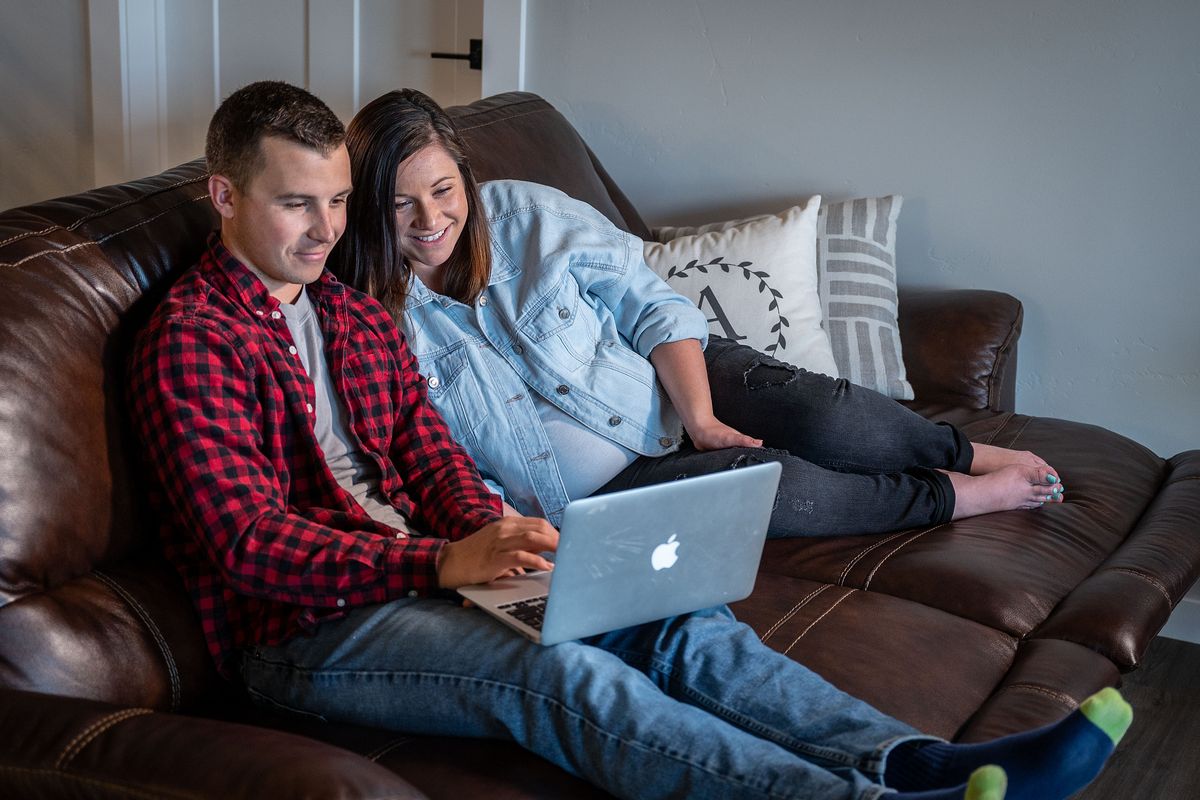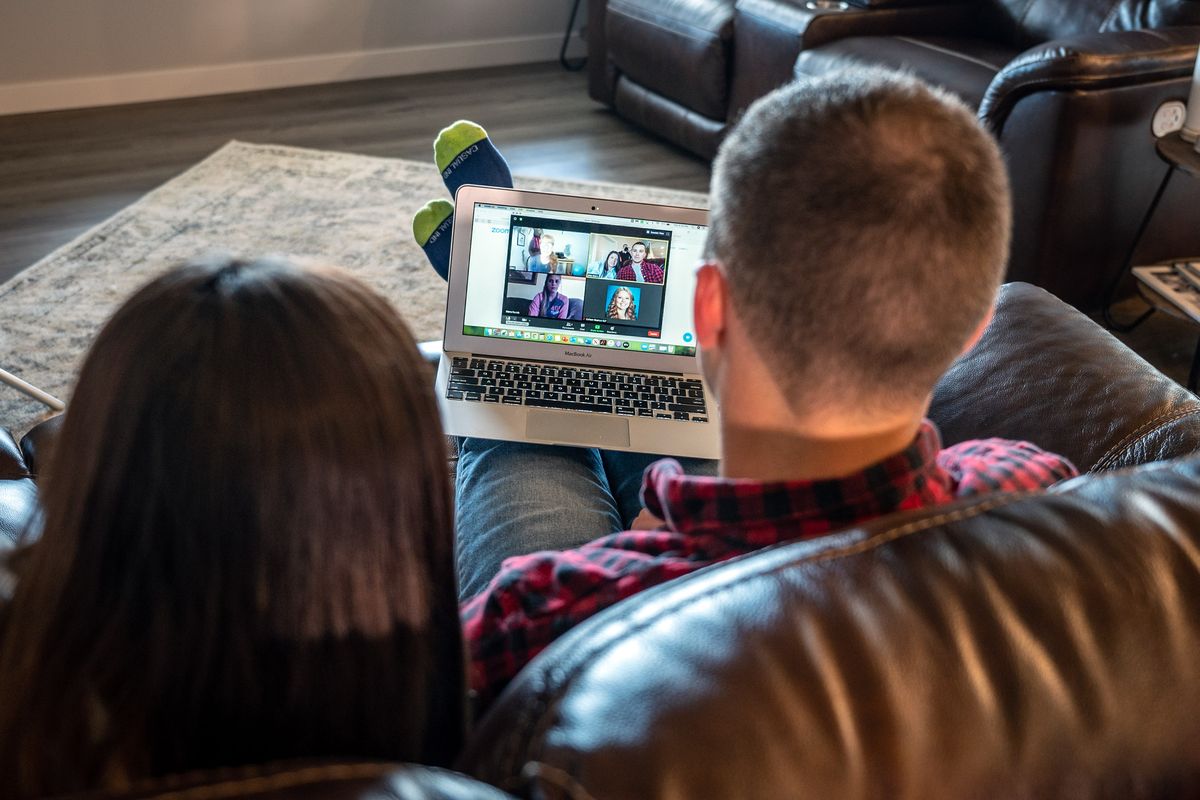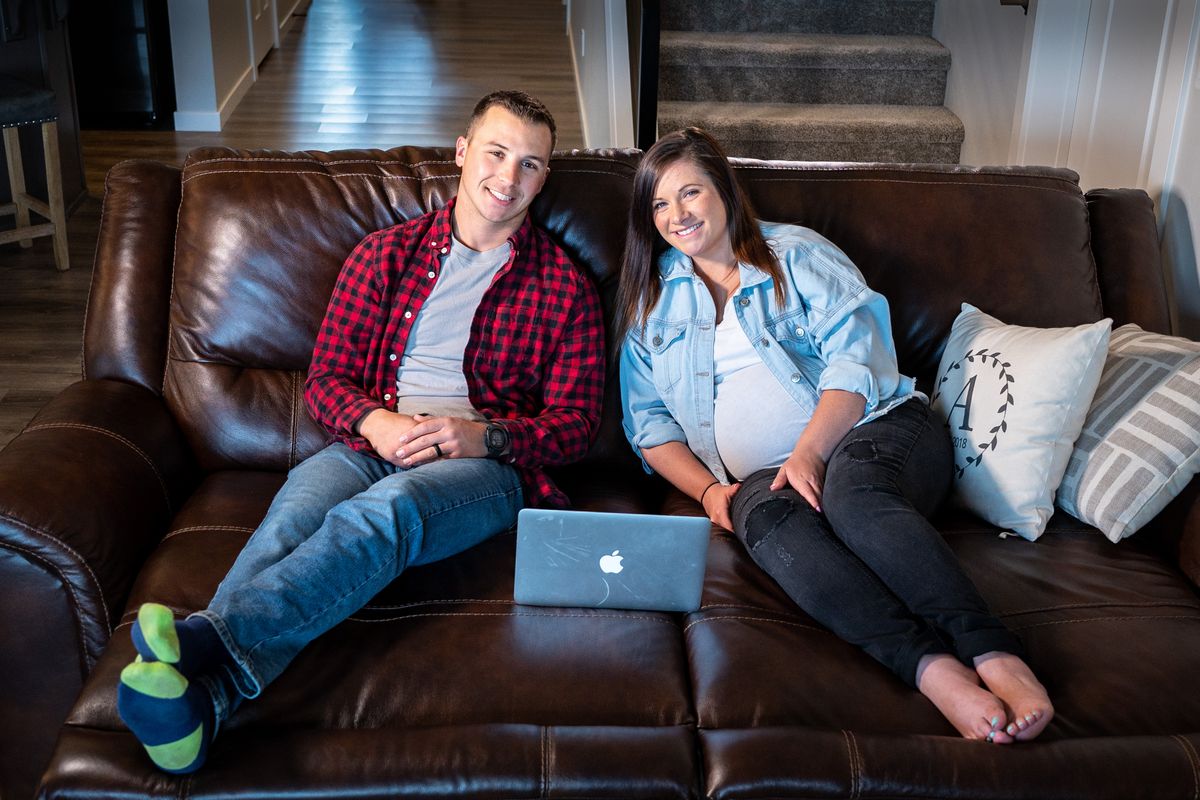Comfort of home: Teacher finds virtual format puts expectant parents at ease
Once a week, Riley and Jena Ayers pull up in the comfort of their home to get questions answered ahead of their first experience with childbirth. The Spokane Valley couple, who are expecting a baby in late May, are in Providence Sacred Heart Medical Center’s Zoom childbirth classes, a total of four Thursdays with a small number of other class members. (Colin Mulvany/The Spokesman-Review)Buy a print of this photo
While relaxing at home, Riley and Jena Ayers heard answers to multiple questions about the birth of their first baby.
Do they want to bring calming lavender scents and music into the labor room? What are steps the father can take to be supportive, and, mostly, what can both of them expect when the time comes?
Using a laptop, the Spokane Valley couple could see screen images of several soon-to-be parents also in their homes as they sat on couches or ate dinner and listened. Pets passed into view oblivious to the Zoom session led by childbirth instructor Clair Bennett.
With her cheerful British accent, Bennett coached them in the Childbirth Prep Class Series offered through Providence Sacred Heart Medical Center.
“I think my favorite part is learning what to ask the doctors or the nurses when you get to the room,” said Jena Ayers, 27, whose baby is due May 27.
“Clair talked about this peanut pillow or a medicine ball. She suggested that even if you don’t know if you’re going to use them to get them just in case. She was telling us about all the equipment for making labor go as smoothly as possible. She’s gotten us familiar with the terms that doctors and nurses would use.”
“She’s made it so, it’s not as scary. The unknown isn’t as scary anymore.”
Riley Ayer, also 27, learned more about how he can help.
“I think the biggest thing for me that we covered so far is for the partners in their support role – what can I do to be supportive not only in coaching her through contractions with breathing or whatever to motivate her, but also how I can help if she needs something from the medical team or just being there with food,” he said.
The $75 childbirth education session, which is Medicaid of Washington accepted, is offered in different time slots that include four two-hour classes. They cover what happens to the mom’s body during birth, what to expect at labor and delivery, and the methods to cope with contractions such as breathing techniques, relaxation and visualization.
Bennett adds videos, and she goes over the pros and costs of pain medications during labor, what the baby needs after birth, basics about the newborn’s care and how to reduce the risk of sudden infant death syndrome.
In an April 8 class that included the Ayers, she cautioned the group against buying products such as sleep position aids that say they prevent SIDS but instead simply put a newborn to sleep on their back against a flat, firm mattress without pillows, toys or blankets.
That prompted questions about babies kept warm in “sleep sack” gowns and swaddling. “Yes, many babies like that,” Bennett told them. “What we say is nothing loose, and we show you how to do that properly, but when the baby’s old enough, maybe 3 or 4 weeks and starts moving around, stop swaddling.”
Although virtual this past year because of COVID-19, Zoom sessions are likely to stay after in-person classes return, Bennett said. She has witnessed how relaxed people are with Zoom in their homes and ask more questions than in a classroom. It also draws people in outlying areas or out-of-state.
Bennett said in a recent class, she had a mother and father who joined the same class, though jobs separated them by a three-hour trip.
“What I found with Zoom, which is interesting, is that the dads ask more questions than they do in the classroom,” Bennett said. “Even though they can see other couples and can still talk to each other, they tend to ask more questions – maybe because they’re sitting on their couch or in their front room, they feel safer.”
More couples are contacting her via email with questions and after the births, with photos of their babies and descriptions about the birth.
“It’s rather like we’ve become friends. I never really connected that way in the classroom, maybe because it is a classroom, and they’re all sitting on seats forward, but this is like I’m coming into their homes.”
“But I think many people still don’t know that we offer these classes. They just assume they are canceled. I’ve had people from Idaho, Washington and Oregon. They’re not delivering at Providence, but they want a live class.”
Bennett said she’s passionate about teaching the class because of what she sees as growing misconceptions and fears around childbirth. Witnessing births, especially by young female relatives, used to be common many decades ago, she said. It’s not in our culture today.
Instead, she’s encountered couples who hear horror stories from relatives or from TV shows or movies.
“I just see more fear surrounding childbirth today than I have in three decades,” Bennett said. “I’m always amazed how little people know about the process of pregnancy and birth.”
But she’s also noticed a difference from when participants first join a childbirth education session to how they are by the end: more confident.
Across the U.S., a majority of pregnant women don’t seek childbirth education statistically, Bennett added. She chalks it up in part to misconceptions or minds made up based on the experience of a relative or friend.
“There has always been quite a lot of misinformation about childbirth education,” Bennett said.
“I think many parents either think I’m going to be this 400-pound woman in a smock teaching them to breathe funny, or they think we’re going to tell them how to give birth. They think, ‘Oh, the doctors know what they’re doing,’ or they’ve already made their minds up, ‘I’m probably just going to get an epidural.’ ”
“Many believe it’s either you go natural and you scream the place down because that’s what they see on TV, or they have to have the epidural, and they don’t realize there’s an awful lot in the middle.”
She tells them about how women can move around a lot, use different positions and relaxation techniques, or ask for nitrous oxide as an inhalation analgesia for pain relief. There are other analgesics that are “halfway between natural and epidurals,” she said.
Jena Ayers said she did have some misconceptions beforehand.
“I always thought I’d be in so much pain, screaming at Riley, squeezing his hand and sweating like what you’d see in the movies,” she said. “Clair has shown us videos of actual births, and she says, ‘this is what it is.’ ”
“She has given us her email and said, ‘Even past this class, I want you to reach out and ask any and all questions.’ So she is going to be a support through all of this.”
It’s all about exploring the options, Bennett said.
“My job satisfaction comes from giving them confidence so whatever happens, they’re informed and know that they can do this. What I always say to my moms and dads in the beginning is it’s not my job to tell anyone how to give birth. I give them all the information, and then they make informed choices.”


